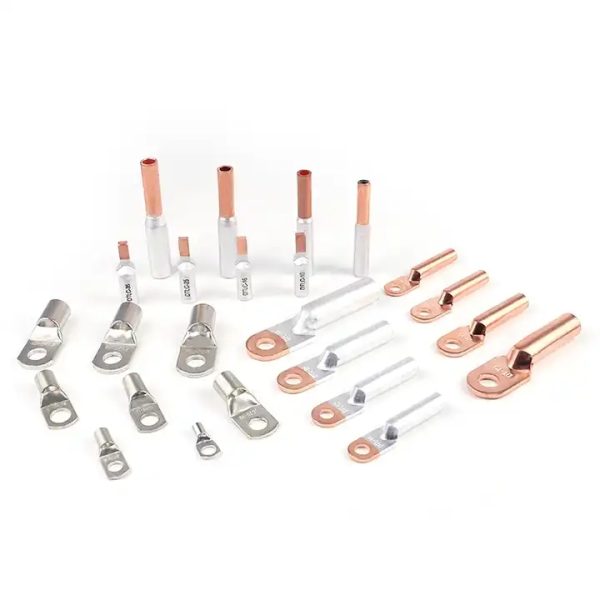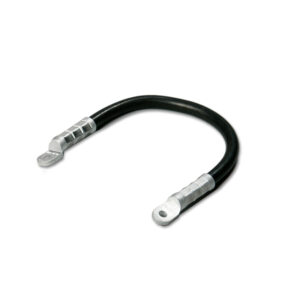Our Location
Table of Contents
ToggleCable lugs refer to devices that connect cables to various electrical appliances. The available common material is aluminum or copper. Cable lugs can be crimped, soldered, or bolted onto the cables and are commonly used in overhead lines, electrical industries, and construction.

Crimp lugs, solder lugs, and compression lugs are the main cable lugs in our market. Each cable lug has its own features and is used in different applications depending on the specific requirements.
Crimp lugs are used to create a reliable connection by crimping them onto the cable. They are easy to install.
 Solder lugs
Solder lugsSolder lugs require soldering to the cable and are used in applications requiring high conductivity.
 Compression lugs
Compression lugs
Compression lugs are designed to be compressed onto the cable with a special tool, providing a secure and reliable connection.

The right cable lug for application has many factors, such as the size, the environment, and the connection’s current carrying capacity.
Cable lugs serve an essential function in electrical systems. They are designed for easy installation and disassembly, making repair and maintenance a breeze. The cable lug is attached to the cable either by welding or crimping, and the connecting end can be fixed to the corresponding position or connection point using bolts, screws, or spring clips. Cable lugs come in various sizes, configurations, and material types to suit specific applications, but aluminum and copper are the most commonly used material. They are used in power cable systems, automobiles, machinery, household appliances, electronic products, and other wiring systems.
For safety reasons, cable lugs are typically insulated with rubber or plastic to prevent accidental electrocution or damage to nearby electrical components.
Drawing is one of the fabrication methods that involves feeding the raw material through a series of steel dies with gradually decreasing diameters. Aluminum alloys are preferred due to their strength-to-weight ratio and recyclability.
The forging process is a core process of cable lugs; it’s critical.
1) Heating aluminum rods
2) The rods are removed from the oven and forged.
3) Cooling them in water.
Forging enhances the strength, ductility, and toughness of aluminum parts. It also generates minimal material waste, making it an efficient production method.
The CNC machining of cable lugs is efficient and saves cost. The specific process is as follows:
1) Edges cutting
2) Hole drilling
3) Threading
4) Deburring
The CNC machining process ensures that the cable lugs are shaped with high precision and accuracy to meet the customer’s required specifications.
Cable lugs are made of copper or aluminum, with similar functionality but different characteristics. Copper has become the preferred metal for lugs, replacing aluminum.
In the 1960s, aluminum was used for electrical wiring and lugs for connections. It led to frequent termination failures and electrical fires. Research showed that aluminum oxide was the main cause. Copper lugs were tried but didn’t work, so copper was chosen as a better metal for electrical wiring.
Copper lugs are safer than aluminum ones as copper has a low coefficient of thermal expansion, making it a non-fire hazard. However, copper is more expensive than aluminum, so aluminum wiring was used before copper.
Aluminum is cheaper but has caused problems before. Copper is good but expensive. We have to consider the difference between the two carefully.
Electrical manufacturers are often attracted to the low cost of aluminum. While copper has been the preferred choice for lugs, recent aluminum-related innovations have made them just as safe. Aluminum lugs are now coated with copper to prevent rusting and oxide formation on the surface.
Aluminum was not the right choice for lugs, but it is now much safer to use aluminum lugs than in the early days. Despite these improvements, the impression that copper lugs are better than aluminum persists. People may need more time to trust aluminum than copper.

Sandblasting can effectively remove rust, oil, and other harmful contaminants from almost any surface. It’s necessary before surface treatment; the primary purpose is to clean the body and ensure a good appearance.
Tin Plating is one of the critical surface finishes of cable lugs. Thickness is essential, and rust might cause significant problems to the function. Plating thickness testing can be measured in microns by a digital thickness meter, which ensures a uniform coating.
Generally, there are two types of tin plating: smooth or textured.
Smooth finishes are essential for applications with low electrical and good corrosion resistance. They also offer a more aesthetically attractive appearance. But, they may not provide optimal grip and can be more prone to slipping than textured finishes.
Textured finishes offer a better grip. They are ideal for use in situations involving vibration or movement and provide better electrical conductivity in some cases. However, they may not be as visually attractive as smooth finishes and may be more corrosion-resistant.

Cable lugs are used in various electrical industries, such as power generation, transmission, and headlines. They are also popular in the automotive and construction industries. Cable lugs withstand high voltage and current levels, making them ideal for industrial applications.

Enze cable lugs are used to terminate and connect cables in electrical components with stud or nut and bolt terminals—available sizes from 6mm to 50mm.
A cable lug is a device used to connect a wire to an electrical terminal. A cable link connects two or more wires.
Cable lugs are a crucial electrical system component, providing a secure connection between cables and equipment. Therefore, choosing the right processes, raw materials, and surface treatment is essential to ensure a safe and efficient operation.
Enze provides all cable lug processes; contact us for a quick inquiry.

